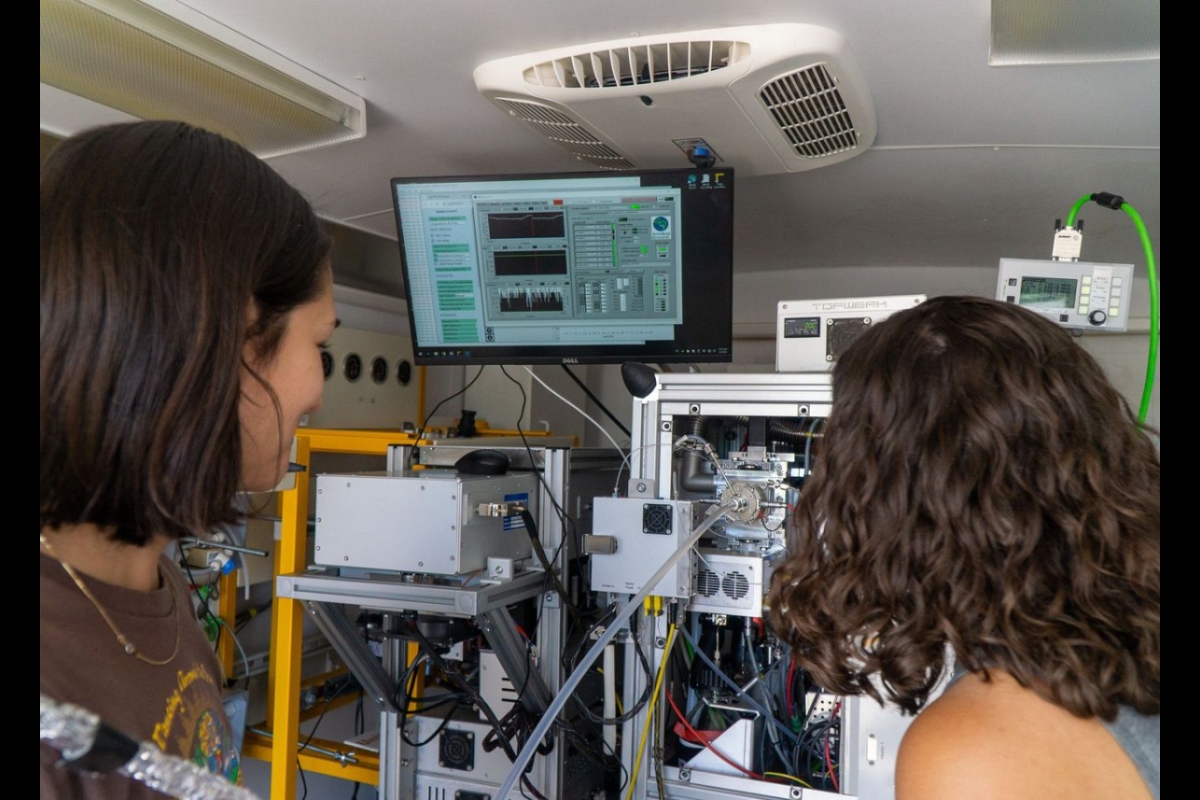Tackling Phoenix’s ozone problem with natural emission research

Using advanced instrumentation hanging high above a west Phoenix neighborhood, an ASU research team is working to better understand how weather conditions, especially heat, may affect the release of naturally occurring emissions from vegetation. Photo courtesy of Pierre Herckes
Phoenix has an ozone problem.
In the summer, residents may see it as a brown haze that hangs over the Valley. Urban emissions with high levels of sunlight create ozone that has made the air over metro Phoenix the fifth worst in the nation, and the region frequently exceeds the health-based federal air quality standards, which can lead to serious respiratory health concerns.
New field research this summer, led by Arizona State University’s School of Molecular Sciences and School of Sustainable Engineering and the Built Environment, is studying natural emission levels in Phoenix to better understand and address the city's ozone pollution problem.
If you enter a forest or smell a flower, the pleasant odors you experience are a mix of naturally occurring emissions called volatile organic compounds (VOCs). These compounds contribute to summer ozone formation, along with human-caused VOCs from gasoline or solvents.
By measuring these naturally occurring emissions and the weather conditions that may be influencing them, ASU researchers aim to improve air quality models and develop more effective strategies for reducing ozone levels.
“A big challenge is figuring out the amount of the critical ingredients that make up our ozone,” said Pierre Herckes, an atmospheric chemistry professor in ASU’s School of Molecular Sciences who co-leads the project. “If we think about regulation based on data, we can begin to determine the best actions to try and address these issues and get lower concentrations of ozone.”
The project, in collaboration with the University of Arizona, is funded by the Arizona Board of Regents and the Arizona Department of Environmental Quality.
Ground-level ozone is created through sunlight-driven chemical reactions between pollutants like nitrogen oxides and VOCs. These pollutants come from sources like car exhaust, industrial emissions and even some plants.
While nitrogen oxide sources are reasonably well understood — mostly coming from energy generation, industry and cars — there is more uncertainty about the sources of VOCs.
VOC emissions occur naturally from both plants and forest fires, as well as human activities like fueling your car, but very few measurements of VOCs have been done in hot and dry climates like Phoenix to calibrate existing models.
“No one's proposing cutting down trees to improve air quality,” said Matthew Fraser, professor in ASU’s School of Sustainable Engineering and the Built Environment and a co-lead in the project. “So we have to understand the uncontrollable emissions, like those coming from vegetation, so that we can determine how we have to control those human sources like industry and vehicles on the road to help improve air quality.”
Using fast response sensors that react quickly to changes in the air to measure how much VOCs are released from vegetation, the team collected chemical data from a west Phoenix neighborhood and coupled it with three-dimensional wind field and temperature information to see how weather conditions, especially heat, may affect the release of VOCs.
The team will compare their real-time measurements with predictions made by computer models that estimate how much of these chemicals should be in the air.
The researchers plan to conduct VOC measurements at two more sites later this summer, one in a natural desert and one in an agricultural area, and will work with the University of Arizona to refine mathematical models to predict air pollution formation.
“It is important that we understand the quantity and types of biogenic VOCs that are being emitted to understand how they impact air quality,” said Trinity Olguin, an environmental chemistry PhD student in ASU’s School of Molecular Sciences working on the project. “Tropospheric (ground-level) ozone directly affects human health. Dealing with the effects of poor air quality is a shared human experience.
“You don't really get to choose what air you breathe, so improving air quality is something that can help everyone.”
The project is being conducted in collaboration with Maricopa County and the ASU Central Arizona Phoenix Long-Term Ecological Research Center.
More Environment and sustainability

From road coatings to a sweating manikin, these ASU research projects are helping Arizonans keep their cool
The heat isn’t going away. And neither are sprawling desert cities like the metro Phoenix area.With new summer records being set nearly every year — 2024 was the warmest year on record for…

New study on Arctic’s ‘Last Ice Area’ highlights the urgency for reducing warming
The Arctic’s “Last Ice Area” — a vital habitat for ice-dependent species — might disappear within a decade after the central Arctic Ocean becomes ice-free during summer, which is expected…

ASU fire expert Stephen Pyne on learning to live alongside fire
Stephen Pyne is having a busy retirement. On top of caring for chickens, sheep and citrus on his urban farm in Queen Creek, Arizona, the Arizona State University professor emeritus is being called on…






